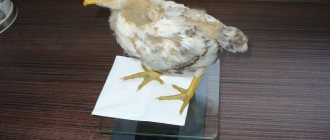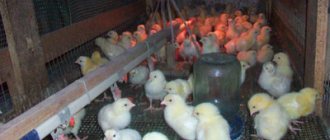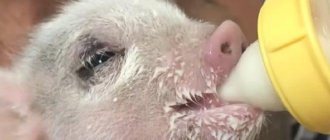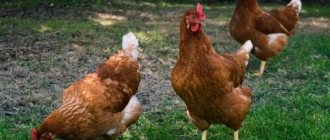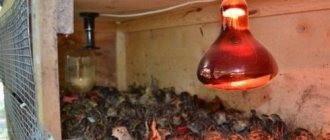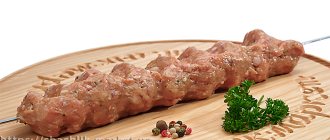Methods of content
Chicks should be purchased from trusted breeders, directly at the poultry farm. You need to refuse to buy livestock from an unknown seller. Before purchasing, it is recommended to ask for documents for such activities and check licenses. It is also better to purchase week-old chicks rather than day-olds. Day-old chicks tolerate changes in environment less well; they are still very susceptible to the negative influence of the external environment. On the road, even if it is short, they can get sick, for example, from a draft.
Broilers can be kept all year round or only in the summer season. The first method is called intensive - when raising chickens does not stop. This is typical for large poultry farms. The second method is called extensive. In this case, livestock is purchased for only one season. Chicks are selected in the spring and raised until mid-summer.
When the chickens gain the required weight, they are sent to slaughter, plucked and cut for meat. This option is suitable for periodic, but not permanent income. With any rearing option, the question of how to properly care for broilers at home remains paramount for the owners.
Cellular
The cage option for raising broiler chickens is the choice of most farmers. Keeping birds in cages is convenient, practical and economical. With this method of rearing, broilers gain weight faster, since they do not have any physical activity.
The movement of chickens is strictly limited; they move only towards the feeder with a drinker and back. At the same time, farmers should not worry - chickens do not need to be walked at all. Hybrids were specially bred with such characteristics and such a disposition that they would be calm and not particularly inquisitive. Movement is not an integral part of the life of chickens. They feel good without active movement.
To keep birds in cages, you need to prepare these bird houses in advance. The cage is purchased at the rate of 1 square meter for 10-15 individuals. If the area is smaller or there are more birds, conflicts between chickens are inevitable. The farmer must think not only about the benefit for himself, but also about the well-being of his pets. If they are cramped in a cage, they will begin to show aggression, fight, peck neighbors or pluck feathers from themselves.
The other extreme is panic among chickens. Due to lack of free space, quons can fall into hysteria, start cackling, screaming, and hitting the wire. The result is injury and trauma, and mental disturbances in birds. This cannot be allowed, because poor health affects the growth of birds and the rate of weight gain.
Pros of home cell growing:
- rapid weight gain;
- the ability to accurately calculate the number of cages and chickens to keep;
- saving space in the chicken coop;
- ease of care;
- cells are convenient to transport (sometimes such a need arises).
When kept in cages, there is no need for bedding. As a result, the risk of broiler infection with pathogenic bacteria is reduced. It is known that mold, mildew and various types of infections spread in litter. This is due to the fact that in a loose environment where there is moisture, bird excrement and food debris, bacteria grow faster and multiply at a breakneck speed. As a result, not just one chicken, but the entire flock may suffer from the disease.
Important! The use of cages protects the owner of the poultry house from such misfortunes. But you still shouldn’t forget to regularly clean the cages and disinfect the feeders and drinkers, especially before introducing new young animals.
If you plan to breed more than 15 chickens, then you will need several cages. In this case, they can be arranged in tiers - one above the other. The main thing here is to correctly regulate the temperature in the room. It is important that the birds on all tiers feel comfortable.
The mistake of inexperienced farmers is that they do not monitor this point. It turns out that the upper tiers suffer from excessive heat, while the birds below freeze from lack of heat. It should be remembered that chickens do not have the opportunity to come closer to the heater or move away from it. This is why it is so important to ensure that the heat is distributed evenly.
Important! In broiler cages, there should always be free access to feeders and drinkers. If this is not taken into account, the chickens will take longer to gain weight. Food bowls and water containers should be placed so that each bird in the cage can easily reach them.
Floor
The floor maintenance method is less environmentally friendly and more costly both in time and finances. However, it is also quite often used in chicken coops . Sawdust is usually purchased as bedding. Before purchasing, you need to check that the sawdust is small in size, without large fragments. Otherwise, chickens may mistake the fractions for food and swallow them.
Features of floor housing for broilers:
- presence of litter;
- constant monitoring of room cleanliness;
- daily change of litter;
- chickens move freely around the premises;
- It is impossible to accurately calculate the number of birds to keep.
On a note! The floor method is more suitable for those who have no more than 15 individuals on the farm. This is an excellent option for small private farms. If you plan to constantly, uninterruptedly raise chickens, then it is better to turn to cage keeping.
Disadvantages of the floor method:
- chickens gain the required body weight more slowly, because they are in constant motion;
- cleaning must be done every day, otherwise harmful bacteria will appear in the litter;
- increased requirements are placed on ventilation, heating and humidity to reduce the risk of bacterial growth;
- high costs of feed and electricity to supply the chicken coop.
Broiler breed COBB-500
A distinctive feature of this bird from other breeds is its yellow skin color. In the consumer market, such meat is always more in demand. Chickens at 6 weeks of age reach a weight of 2 to 2.5 kilograms and are suitable for slaughter. COBB-500 has strong immunity to various diseases, as well as 100% survival rate. Broilers have large legs and a wide chest, which is undoubtedly an advantage when raising broilers for meat at home. One of the advantages of this cross is that all birds have almost the same weight and height.
The necessary conditions
Before placing young animals purchased from breeders into the chicken coop, you should prepare the premises. If this is not done, then it is likely that the livestock will not take root. This is fraught with the loss of chicks and the money spent on their purchase. There are not many necessary conditions for preparing a chicken coop before introducing young animals there. But all poultry farmers should remember these few points and adhere to them impeccably.
Stages of preparing a poultry house for a new broiler population:
- It is necessary to treat the premises from parasites and pathogenic bacteria. Processing is carried out using disinfectants. They can be purchased at pet stores or specialized markets.
- The walls of the poultry house are being plastered. A layer of lime is applied on top of the plaster. This protects the chicken coop from possible growth of mold and mildew. Plaster is also used to seal small cracks through which cold air passes.
- You need to decide on the type of content - will it be cage or floor cultivation. Based on your choice, organize the poultry house space accordingly. Either fence off the pen area or install tiers of cages.
- Next you need to adjust the temperature. It should fluctuate between 25-30 degrees Celsius. If it is winter, the mark should not fall below 18-20 degrees Celsius. You also need to carefully check for cracks and gaps in the walls, floor, and ceiling, paying special attention to the corners of the room. If cracks are found, they must be sealed using wood, concrete, sheathing or insulation.
- The next stage is ventilation. She must be present in the chicken coop. The health of chickens will largely depend on the quality of ventilation equipment. Ventilation will remove stale air and provide a constant supply of fresh air masses. Harmful fumes and gases will be removed from the room along with the air.
- Before introducing birds, you need to adjust the lighting. The light should be bright, but not blinding, otherwise the broilers will quickly get tired. Also, when purchasing lighting fixtures, you need to decide in advance which power sources they will be connected to. It is important to calculate the power of the devices and the load on the electrical network. Otherwise, there may be a risk of network overload and an emergency situation.
- Finally, if you plan to keep it on a litter, you need to purchase sawdust. You should also prepare the floor - wash it, treat it from mold and mildew, and add a layer of quicklime. Then sprinkle sawdust on top.
Important! In the first month of the young animals’ life, it is necessary to especially carefully monitor the cleanliness of the chicken coop. The litter needs to be changed every day and disinfected once a week. Such care measures will protect the chickens from diseases and allow them to grow into healthy broilers.
Temperature
The recommended temperature for keeping broilers is about 30 degrees Celsius. The thermometer mark should not fall below 18 degrees. A similar risk arises in winter, when it is frosty outside. During this season, it is necessary to connect additional heating so that the chickens do not freeze or get sick.
Broilers are generally quite strong in health, but we must remember that they do not tolerate drafts. It is necessary to protect the feathered pets from the cold wind, insulate the walls of the poultry house and seal all discovered cracks.
When introducing young animals, you need to monitor the temperature almost every day. In the first week, you need to set the maximum temperature - 30-35 degrees Celsius. Then, in the second week, the temperature should be gradually lowered.
You should start from day 6-7, lowering the temperature to 28 degrees. Then, from the third week, the heat level must be reduced by 3 degrees, until the fourth week of the chicks’ life. Thus, by the age of one month, birds should live at a temperature of 18-20 degrees Celsius.
Humidity
The humidity in the room where the chickens live should be kept at 70-80%. This is the optimal indicator, since with it the birds will feel comfortable, and pathogenic bacteria will not multiply as quickly as at a higher level. Humidity is regulated using a ventilation system. It is this, coupled with the set temperature, that helps to adjust the desired humidity in the chicken coop.
Much also depends on the region where the birds are kept. In some areas, the humidity itself is high, which promotes the development of fungus and mold, especially if the floor growing method is used. In other areas, the climate is dry, and this may lead to another problem – lack of humidity. Therefore, it is necessary to take into account all aspects, including the territorial location of the poultry house. And, based on this, build a humidity regime.
Feeding
There are several ways to feed broiler chickens, as well as raise them. Each option has its own advantages and disadvantages. The owners individually choose the appropriate method, the most optimal in terms of costs and results.
Broiler feeding options:
- Prepare your own food. Wheat and corn grains are used for the base. Soybean and sunflower meal are added, and bone meal is mixed in. The food can be dry or wet. In the second case, it is recommended to warm it up slightly. Along with the food, chickens are given vitamin supplements and mineral complexes. They must be drunk in order to prevent the risk of developing all sorts of diseases. Vitamins also help strengthen the overall immune system. The advantage of this feeding option is that it saves money. The downside is that chickens take a long time to gain weight. The growing period increases from 2 weeks to a month - it all depends on what exactly the owner feeds the chickens.
- Preparation of feed with the addition of BMVD. The advantages are that birds immediately receive the required amount of vitamins and minerals. The farmer needs to think less about the components of the feed, since he immediately adds a useful additive to it. The mixture contains many ingredients, in particular yeast, sunflower cake, bone meal, soybean meal, and so on. The composition is always indicated on the packaging; it can be easily studied. The disadvantage of this option is that inexperienced farmers cannot correctly calculate the proportion of additive and feed. It turns out that chickens receive either too many vitamins or very few. Both have a negative impact on their growth and development.
- Compound feed is the most popular feeding option. It already contains all the necessary additives; the farmer just needs to add the required portion size and no longer worry about feeding the chickens. Each age has its own feed, each of which has its own name. The advantages of compound feed are obvious - birds quickly gain weight, you can clearly calculate your costs, and you do not need to use additional food additives. One of the disadvantages is the risk that if the owner starts overfeeding the birds, they will get sick. But this is not a drawback of the feed; it is rather a requirement for the farmer to be attentive.
Important! With any feeding method, you must remember that the chickens’ diet should be varied. Even if birds are fed with compound feed, they should be given fresh greens periodically.
However, there is a list of foods that should never be fed to broilers:
- boiled potatoes;
- poor quality products;
- expired products;
- sausage and smoked meats;
- citrus;
- watermelon;
- melon;
- cheese;
- chocolate and other sweets;
- new milk;
- butter;
- alcohol.
In addition to providing your feathered pets with food, you must also remember about water. The drinking bowls should always be filled, but the water should be changed regularly. The drink should be clean, and the water itself should be settled and preferably warm. Recommended temperature is 20 degrees.
Boiling water should not be served to chickens in the same way as ice-cold drink.
What and how to feed broiler chickens in the first week?
feeding broilers in the first days
During incubation, the chick uses nutrients from the egg to develop. After hatching, the body undergoes a physiological adjustment to absorb nutrients from food. At this moment, feed consumption is minimal, and the need for nutrients is maximum.
To feed broilers in the first 10-14 days of life, a starter feed recipe is used. This food contains high amounts of protein, vitamins, minerals and amino acids, and has the highest cost. The composition of the starter diet may include wheat, corn, soybean meal, sunflower meal, sunflower oil, monocalcium phosphate, lime flour, and BVMK. Compound feed is given to the bird in the form of grits or mini-pellets with a particle size of 1.5-3 mm.
In the first days, it is important to ensure easy access to feed for the birds. Healthy chickens arrive at the poultry house from the incubator hungry, and immediately after landing they begin to actively consume feed and water. Food should be easily accessible and in abundance. Therefore, in the first days of cultivation, in addition to filling the automatic feeding lines, they use food sprinkled on paper. The amount of feed on paper is calculated based on 40 grams per head. The paper is laid out near the drinking lines.
In order to teach chicks to use an automatic feeding line, it is important that the feeders are completely filled with feed from the first days of rearing. However, using high-sided feeders makes it difficult for chicks to find and access the feed. Often, more active birds will climb into the feeder and stay there, contaminating the feed with droppings. Dirty and compressed food becomes unattractive for consumption. It must be disposed of.
A tool for checking the well-being of chickens in the first days of rearing, the availability of feed and water for the population, is to check the filling of the crops. After 24 hours, more than 95% of tested individuals should have a well-filled goiter. If the filling is unsatisfactory, you need to find the problem as soon as possible. The most common cause is insufficient feed on paper, water shortage or microclimate conditions in the poultry house.
Diseases and prevention
Hybrid breeds have strong immunity. Breeders have worked for a long time to ensure that broilers are unpretentious in care and do not require increased attention to their health. If you follow the recommendations and advice on keeping broiler chickens, then diseases will bypass them.
The main rules for disease prevention:
- Keep the poultry house clean. Change bedding and clean cages, disinfect drinking bowls and feeders.
- Give the young animals a vitamin-mineral complex to drink. This must be done in the first two weeks of the birds’ life.
- If a disease is detected in any bird, immediately remove it from the chicken coop, call a veterinarian and check the health of the remaining birds.
Broilers do not have any special diseases. What they can get sick with is common to all poultry. Below is a list of the most common ailments to keep in mind:
- Poisoning - occurs as a response to feeding stale and low-quality products, or ingredients from the prohibited list.
- Ascites – in other words, obesity. Consequence of incorrect dosage of feed. At the first signs, you need to reduce the number of servings to the recommended amount.
- Arthritis is a common disease in caged chickens. If the cage area is incorrectly calculated, the birds will not be able to move at all. As a result, their leg muscles will completely atrophy, which will lead to death. If the chickens feel crowded, you need to buy additional cages and spread them out. It is worth sticking to the calculation of one square meter per 10-15 individuals.
- Salmonellosis is the name for indigestion. Occurs due to bad food or infection. To avoid salmonellosis, you need to thoroughly clean the cages, as well as disinfect drinking bowls and feeders so that unwanted bacteria do not multiply on their surfaces.
- Heteracidosis, or worms. Prevention is the same as for salmonellosis and poisoning - check the quality of the chickens' food and disinfect the chicken coop.
Important! The veterinarian decides how to treat sick animals after an examination. It is better not to experiment on your own, so as not to harm your pets with incorrect treatment.
A separate point is drafts. This is perhaps the only thing that broilers are very afraid of. Chickens cannot tolerate cold and drafts, so before moving the young animals into the house, all cracks, even the smallest ones, must be sealed.
Broiler chickens are domestic birds with minimal care requirements. That is why their cultivation is so popular among poultry farmers. But it’s also worth remembering that ducks and even turkeys can be broilers, so you don’t need to limit yourself to chickens alone. The main thing is to choose the breed you like and follow simple tips for keeping it. The costs of purchasing broiler chickens and caring for them will pay off within 2 months. It is from this age that birds can be sent for slaughter and cut up for meat.
